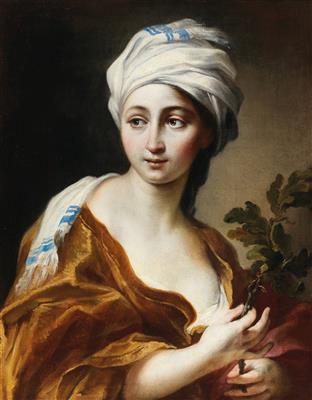Stefano Maria Legnani, il Legnanino

(Milan 1660–1713 Bologna)
An Allegory of Virtue,
oil on canvas, 74 x 59 cm, framed
We are grateful to Marco Riccòmini for confirming the attribution of the present painting on the basis of a high-resolution photograph and for his help in cataloguing this lot.
The young woman seen gazing thoughtfully, looking beyond the viewer is depicted wearing a white turban with a blue striped border, that is partially unravelled on her shoulder; in her hands, she holds a branch of green oak leaves. Her attributes can be identified from the pages of Cesare Ripa’s Iconologia (Rome 1593, pp. 289-290) describing the allegorical figure of Virtue. Since antiquity, owing to the robust resistance of its wood, the oak tree was considered a symbol of strength, loyalty and therefore also of virtue, and moreover, it is worth noting that the prize in many competitions held in ancient Greece consisted of an oak crown.
The present painting is therefore an allegory of Virtue in the guise of a young woman. The model seen here reoccurred frequently in the pictures of the Milanese painter. For example, she appears at the centre of the fresco representing the Continence of Scipio in one of the lunettes painted by Legnanino in the so-called ‘prima anticamera’ of the ground floor of the Palazzo Carignano in Turin (see M. Dell’Omo, Stefano Maria Legnani ‘Il Legnanino’, Ozzano Emilia 1998, p. 60, p.78, fig. 11, p. 183, no. 48b). This work dates to the Milanese painter’s full maturity, between the final years of the seventeenth century, and the first of the eighteenth century (circa 1695-1700).
The iconographic choices deployed in the fresco cycle for the ground floor of the Turin residence of the Principe di Carignano, Emanuele Filiberto Amadeo (1628–1709) are considered. Indeed, Legnanino was called upon to depict an unusual subject, that in which Scipio chose a path of virtue – a theme that aimed to celebrate the moral attributes of the patron– therefore underlining the ‘moral integrity of a sovereign who was not only a warrior, and thus his choice of Virtus over Voluptas’ (op. cit. Dell’Olmo, 1998, pp. 185-186). In this context, it is therefore possible to propose that the present Allegory of Virtue was likely conceived in Turin, as part of the furnishings intended for the elderly Prince of Carignano, or his court.
22.10.2019 - 18:30
- Stima:
-
EUR 15.000,- a EUR 20.000,-
Stefano Maria Legnani, il Legnanino
(Milan 1660–1713 Bologna)
An Allegory of Virtue,
oil on canvas, 74 x 59 cm, framed
We are grateful to Marco Riccòmini for confirming the attribution of the present painting on the basis of a high-resolution photograph and for his help in cataloguing this lot.
The young woman seen gazing thoughtfully, looking beyond the viewer is depicted wearing a white turban with a blue striped border, that is partially unravelled on her shoulder; in her hands, she holds a branch of green oak leaves. Her attributes can be identified from the pages of Cesare Ripa’s Iconologia (Rome 1593, pp. 289-290) describing the allegorical figure of Virtue. Since antiquity, owing to the robust resistance of its wood, the oak tree was considered a symbol of strength, loyalty and therefore also of virtue, and moreover, it is worth noting that the prize in many competitions held in ancient Greece consisted of an oak crown.
The present painting is therefore an allegory of Virtue in the guise of a young woman. The model seen here reoccurred frequently in the pictures of the Milanese painter. For example, she appears at the centre of the fresco representing the Continence of Scipio in one of the lunettes painted by Legnanino in the so-called ‘prima anticamera’ of the ground floor of the Palazzo Carignano in Turin (see M. Dell’Omo, Stefano Maria Legnani ‘Il Legnanino’, Ozzano Emilia 1998, p. 60, p.78, fig. 11, p. 183, no. 48b). This work dates to the Milanese painter’s full maturity, between the final years of the seventeenth century, and the first of the eighteenth century (circa 1695-1700).
The iconographic choices deployed in the fresco cycle for the ground floor of the Turin residence of the Principe di Carignano, Emanuele Filiberto Amadeo (1628–1709) are considered. Indeed, Legnanino was called upon to depict an unusual subject, that in which Scipio chose a path of virtue – a theme that aimed to celebrate the moral attributes of the patron– therefore underlining the ‘moral integrity of a sovereign who was not only a warrior, and thus his choice of Virtus over Voluptas’ (op. cit. Dell’Olmo, 1998, pp. 185-186). In this context, it is therefore possible to propose that the present Allegory of Virtue was likely conceived in Turin, as part of the furnishings intended for the elderly Prince of Carignano, or his court.
|
Hotline dell'acquirente
lun-ven: 10.00 - 17.00
old.masters@dorotheum.at +43 1 515 60 403 |
| Asta: | Dipinti antichi II |
| Tipo d'asta: | Asta in sala |
| Data: | 22.10.2019 - 18:30 |
| Luogo dell'asta: | Wien | Palais Dorotheum |
| Esposizione: | 12.10. - 22.10.2019 |
